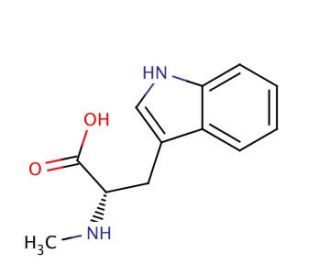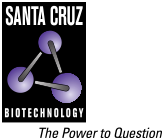
Click on image or enlarge button to enlarge

L-Abrine: sc-257646
L-Abrine (CAS 526-31-8)
Alternate Names:
Nα-Methyl-L-tryptophan
CAS Number:
526-31-8
Molecular Weight:
218.25
Molecular Formula:
C12H14N2O2
For Research Use Only. Not Intended for Diagnostic or Therapeutic Use.
* Refer to Certificate of Analysis for lot specific data.
QUICK LINKS
Ordering Information
Description
Technical Information
Safety Information
SDS & Certificate of Analysis

L-Abrine is a compound that garners attention in the field of biochemical research due to its structural similarity to the amino acid tryptophan. In research applications, L-Abrine is often explored for its role in protein synthesis studies, where it can be incorporated into peptides to investigate the effects of structural analogs on protein function and stability. Its incorporation into proteins can also serve as a tool to study protein-protein interactions and the specificity of enzyme-substrate relationships. Additionally, L-Abrine is of interest in metabolic studies to understand how cells process structurally similar amino acids, which can provide insights into the selectivity and regulation of amino acid transporters and metabolic pathways. Researchers may also use L-Abrine to probe the mechanisms of amino acid recognition by ribosomes during translation, which is fundamental to understanding the fidelity of protein synthesis.
References:
- Endogenous and dietary indoles: a class of antioxidants and radical scavengers in the ABTS assay. | Herraiz, T. and Galisteo, J. 2004. Free Radic Res. 38: 323-31. PMID: 15129740
- Molecular analysis of a 4-dimethylallyltryptophan synthase from Malbranchea aurantiaca. | Ding, Y., et al. 2008. J Biol Chem. 283: 16068-76. PMID: 18390548
- Substrate promiscuity of the cyclic dipeptide prenyltransferases from Aspergillus fumigatus (section sign). | Zou, H., et al. 2009. J Nat Prod. 72: 44-52. PMID: 19113967
- Quantification of L-abrine in human and rat urine: a biomarker for the toxin abrin. | Johnson, RC., et al. 2009. J Anal Toxicol. 33: 77-84. PMID: 19239732
- Biochemical characterization of a novel indole prenyltransferase from Streptomyces sp. SN-593. | Takahashi, S., et al. 2010. J Bacteriol. 192: 2839-51. PMID: 20348259
- A portable and chromogenic enzyme-based sensor for detection of abrin poisoning. | Cho, H. and Jaworski, J. 2014. Biosens Bioelectron. 54: 667-73. PMID: 24334282
- A case of abrin toxin poisoning, confirmed via quantitation of L-abrine (N-methyl-L-tryptophan) biomarker. | Wooten, JV., et al. 2014. J Med Toxicol. 10: 392-4. PMID: 24522983
- A 7-dimethylallyl tryptophan synthase from a fungal Neosartorya sp.: biochemical characterization and structural insight into the regioselective prenylation. | Miyamoto, K., et al. 2014. Bioorg Med Chem. 22: 2517-28. PMID: 24657051
- Rapid method using two microbial enzymes for detection of L-abrine in food as a marker for the toxic protein abrin. | Dodge, AG., et al. 2015. Appl Environ Microbiol. 81: 1610-5. PMID: 25527549
- Isolation, Solid-state Structure Determination, In Silico and In Vitro Anticancer Evaluation of an Indole Amino Acid Alkaloid L-Abrine. | Laskar, S., et al. 2019. Curr Cancer Drug Targets. 19: 707-715. PMID: 30636612
- Massive fatal overdose of abrin with progressive encephalopathy. | Horowitz, BZ., et al. 2020. Clin Toxicol (Phila). 58: 417-420. PMID: 31456429
- Taking Different Roads: l-Tryptophan as the Origin of Psilocybe Natural Products. | Lenz, C., et al. 2021. Chempluschem. 86: 28-35. PMID: 33237633
- Regioselective Biocatalytic C4-Prenylation of Unprotected Tryptophan Derivatives. | Eggbauer, B., et al. 2022. Chembiochem. 23: e202200311. PMID: 35770709
- Metabolomic Characterization of Acute Ischemic Stroke Facilitates Metabolomic Biomarker Discovery. | Qi, B., et al. 2022. Appl Biochem Biotechnol. 194: 5443-5455. PMID: 35789984
- Structural features of L-tryptophan required for activation of TRAP, the trp RNA-binding attenuation protein of Bacillus subtilis. | Babitzke, P. and Yanofsky, C. 1995. J Biol Chem. 270: 12452-6. PMID: 7759487
